
Chapter 5: Craters (1/6)
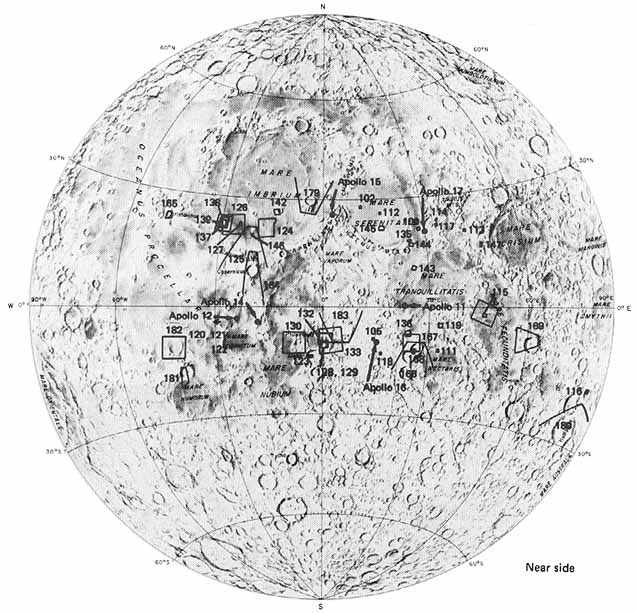 |
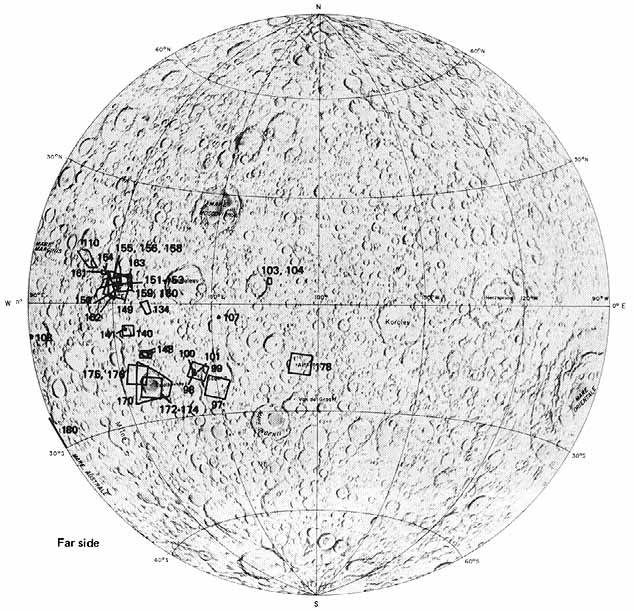 |
|
[104] Figure 96. Location of photographs in this chapter; numbers correspond to figure numbers. [Base map courtesy of the National Geographic Society] |
[105] The most common process that affects the lunar surface is impact cratering. Craters range in size from those that are 1000 km across and can be seen with the naked eye from Earth to those that are so tiny that the most powerful microscopes are required to study them. These tiny craters are abundant on the smallest grains in samples brought back from the Moon. In general, the size of the largest craters that pepper a particular surface is a measure of the age of that surface. Younger areas contain small craters; very old areas are covered with very large craters.
In addition to giving a measure of the age of the lunar surface, craters provide information about other processes that affect the Moon. Study of the shape of the craters and the distribution of the material ejected from the craters gives information on the nature of the projectile, its energy, and direction of impact. In turn, this information tells what kind of object caused the crater-whether it was a low density cometlike object or a high density asteroid.
Study of the material ejected from craters provides data on the temperature and pressures caused by the impact. Changes in the chemistry of the materials and in the mineral form-called impact metamorphism also give clues to the nature of the projectiles. Of course, if pieces of the impacting object can be found, a direct determination can be made.
To better understand lunar impact structures, studies have been made of natural impact craters on the Earth as well as of manmade craters. Detailed studies of the craters made by explosives, ballistic missile impact, or by firing projectiles from high velocity guns at rock targets have resulted in some understanding of the process by which craters are made. As the high-velocity projectiles enter the target, a compressional shock wave spreads away from the entrance point, followed by a rarefaction wave that throws most of the ejecta out of the crater. Finally, the floor of the crater rebounds, forming the central peak. Three kinds of deposits can be found around a crater. One kind is the lines of ejecta thrown out along ballistic paths that are lines of secondary craters. On the Moon, these form the bright rays that extend for 10 to 30 crater diameters. A second type occurs when a continuous blanket of ejecta extends outward one to two crater diameters: such a covering formed by movement of the ejected material along the surface is the so-called "base surge." This flowing material may form ridges and dunes that vary according to the velocity of the flow and the preexisting shape of the surface. Molten ejecta can flow down the interior [106] walls of an old crater in its path and form a puddle on the crater floor or flow down the outside sloping rim of the crater. The third type of deposit is the lines of ejecta radiating from the central peak. These materials are the last to be ejected from the crater.
Craters fall into three groups. First, there are primary craters, which are generally randomly placed. Occasionally cosmic debris has struck the Earth in long lines, forming features such as the Campo de Cielo line of meteorite craters in South America; such an alinement of primary craters could occur on the Moon. Second, there are radiating and looped patterns of smaller craters surrounding the larger primary impact crater. These secondary craters in turn may have fans of ejecta thrown out from them in the direction away from the primary crater. Third, there are craters of internal (volcanic) origin. These have a different form, are often alined along fractures, and have ejecta blankets of different style and form from those of impact craters. Impacted ejecta has many blocks and forms very hummocky deposits; volcanic ejecta is fine "rained and usually smooth.-H.M.
FIGURE 97 [below].-Craters, craters, craters! The far side, even more than the near, presents a tortured record of the bombardment suffered by the Moon throughout its history. This scene exemplifies the relentless attack of impacting objects from space and from the lunar surface that has characterized most of lunar history.
The craters in this far-side area come in various shapes, sizes, and degrees of degradation attesting to a variety of formative processes, energies of formation, and ages. Each individual circular crater was probably produced by the impact of a body from interplanetary space- the larger the crater, the higher the energy; that is, the larger the body, or the greater its velocity upon impact. The first and largest such impact erased all earlier features and produced the crater that fills most of the scene, Gagarin, 265 km in diameter (rim crest outlined). A series of smaller craters followed, starting with crater A (46 km), itself heavily cratered, and ending with the sharp funnel-shaped craters and crater C(14 km). The young age of crater C is demonstrated by the sharpness of its rim crest and its halo of extremely fine, fresh ejecta and secondary craters. During the rain of objects from space, clots of lunar material ejected from impact craters outside this area landed here to form irregular secondary craters. Examples (D) are the elongate partly filled crater near the upper right corner and the elongate but deeper craters in the upper left. Conceivably, however, some irregular craters were formed by volcanism, a process that at one time was widely believed to be the cause of most irregular craters on the Moon. At some time late in the history of the region, an even more distant impact hurled a loose cluster of debris to form the group of sharp, circular (high-energy) craters in the left center of the picture.
In this section of the book other primary and secondary craters will be illustrated as will some possible volcanic craters and some craters whose properties are too obscured to reveal their origin-like crater B and its twin Iying inside the older crater A in this picture.-D.E.W.
|
[107] |
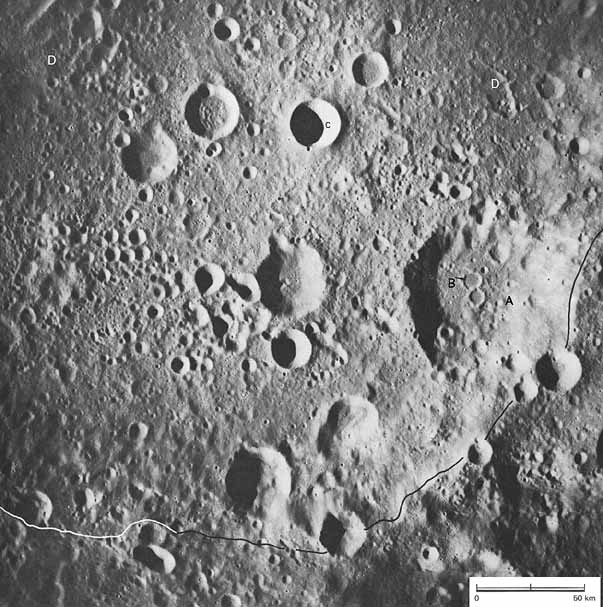 |
|
[108] FIGURE 98 [right].-This slightly oblique Hasselblad photograph, taken from Apollo 17, is an excellent view of a small, very young impact crater. Slightly less than 3 km in diameter, it is located on the west flank of the large crater Gagarin on the lunar far side. The youthfulness of this small crater is illustrated by its sharply defined rim crest; by its bright continuous blanket of ejecta extending outward for 1 to 2 crater diameters; and, most particularly, by its exceptionally welldeveloped radial pattern of bright rays. The rays consist of narrow, diffuse streaks and shorter bright spots. They are formed when ejected material from the impact site is redeposited as projectiles in the form of discrete blocks and clusters of disaggregated debris. The brightening is probably caused by the shock effects on the rock that was excavated from the impact site and deposited onto the older, darker surface materials.-F.E.-B.
|
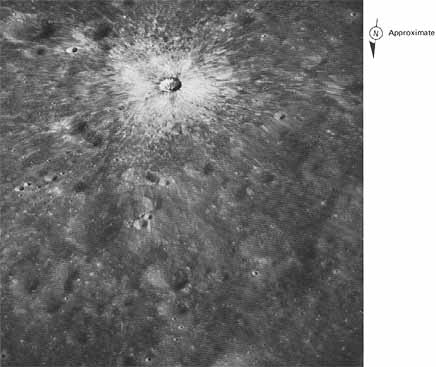 |
|
| |
|
FIGURE 99 [right].-This is the same small crater as appears in figure 98, oriented in the same way, but shown in a vertical view taken with the panoramic camera on Apollo 15. The western rim of Gagarin is marked by a dashed line. For easier comparison with figure 98, north is at the bottom. The Sun angle is very nearly the same in both pictures, but the oblique view recorded by the Hasselblad camera is certainly more spectacular. However, in many respects this vertical view is better suited for detailed study. The symmetries of the crater proper, its ejecta blanket, and its pattern of filamentous rays are even more apparent. Some of the rays extend to the edge of the frame, a maximum distance of slightly more than 50 km, or about 15 times the diameter of the crater. Figures 100 and 101 are enlargements of other photographs of the small areas indicated by rectangles.-G.W.C.
|
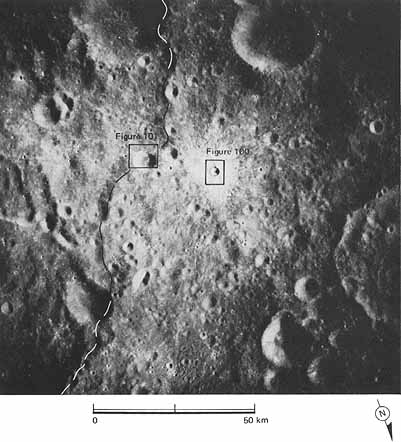 |
|
[109] |
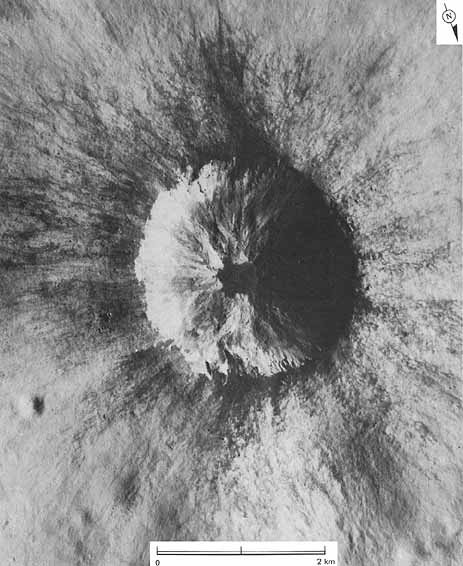 |
FIGURE 100 [above].- This is an enlargement of a small part of a panoramic camera frame showing the same crater in much more detail. The high resolution inherent in the camera system shows that the bright radially grooved ejecta contains many large blocks near the rim and that dark fine-textured material overlies the light coarse ejecta. Notice how the dark material occupies depressions on the rim, slumps down the walls, and forms a smooth-surfaced pool at the bottom of the crater. Also visible are ridges of bedrock in the upper walls and lobes of light-colored debris extending down onto the floor. Most aspects of the crater indicate that it was formed by impact. The dark material probably was penetrated at depth and ejected late in the explosive stage to accumulate in the vicinity of the rim. A volcanic origin for the dark material is possible but less likely.-B.K.L
|
[110] |
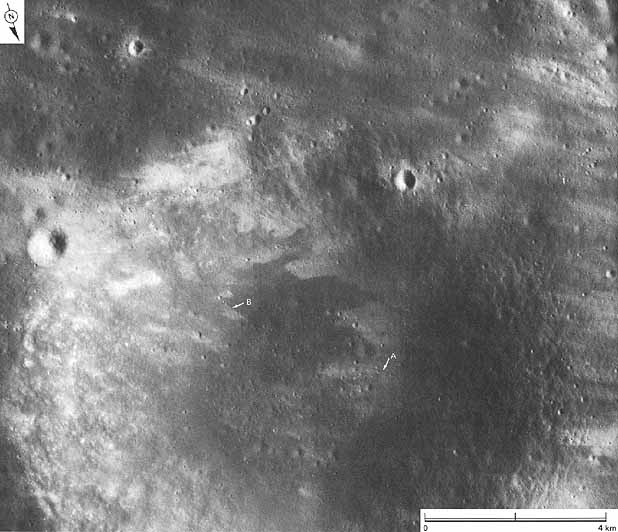 |
FIGURE 101 [above].-Ray material from the fresh crater described in figures 98 to 100 covers an old, degraded 12-km crater located a few tens of kilometers farther east (fig. 99). The light linear streaks and pointed markings are the rays from the fresh crater. In this picture the light material overlies dark regolith. Fine linear depressions (A) in the light patches are chains of secondary impact craters. They are associated with most of the light patches, and in some places (as at B), lie at their origin, thus showing that much of the ray material may be composed of local material disturbed by secondary impacts. In some places no such association is obvious, and the rays may consist of material ejected from the primary crater.-B.K.L.
[111] FIGURE 102 [below].-The characteristics of an extremely youthful small crater are illustrated in this Apollo 15 panoramic camera photograph of the crater Linne' as viewed from the south. The 4-km-diameter crater is located in the western part of Mare Serenitatis. The rim of the crater slopes steeply up from the mare surface, and the rim crest is sharp and even. Boulders are abundant on and near the rim. Concentric dunelike features occupy the inner part of the ejecta blanket and, with increasing distance from the crater, give way to irregular arcuate clusters of satellitic craters. A more subtle radial pattern in the ejecta can be seen where the Sun's rays shine across it, to the north and south of the crater. The bright ejecta blanket and ray pattern displayed here are typical of very youthful craters of all sizes.-M.C.M.
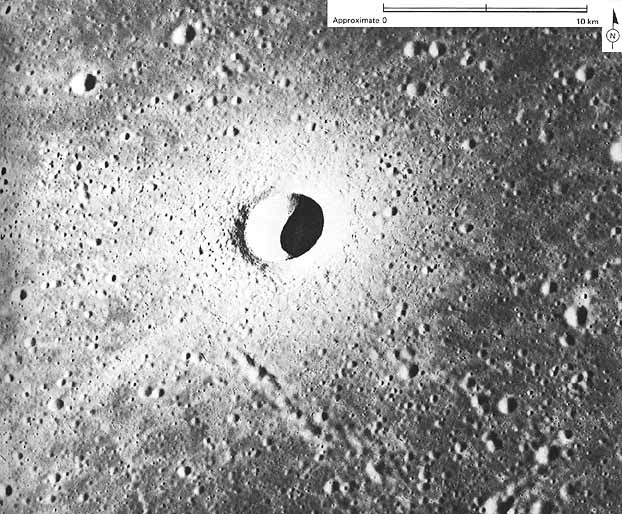
|
[112] FIGURE 103 [right].-This view looks southward near Mandel'shtam on the lunar far side. Most young lunar craters wider than about 40 km have flows on their rims that resemble lava flows or mud flows on Earth. The unnamed crater near the top is about 14 km wide and was recognized by H. J. Moore (1972) as being the smallest crater known to have such flows. Flows in the middle of the picture surged downhill off the high rim of the crater making lobes and tongues and leaving behind drained channels with levees. In the area to the right of the crater, enlarged in figure 104, are some thin lobate flows that apparently rode over small hills, as if these flows were propelled outward from the crater with sufficient velocity to climb the hills. Ejecta deposits farther than about 1 km from the rim are radially lineated and are smoother than the ground immediately surrounding the crater. The crisp, blocky zone around the crater is typical of many fresh craters.-K.A.H.
|
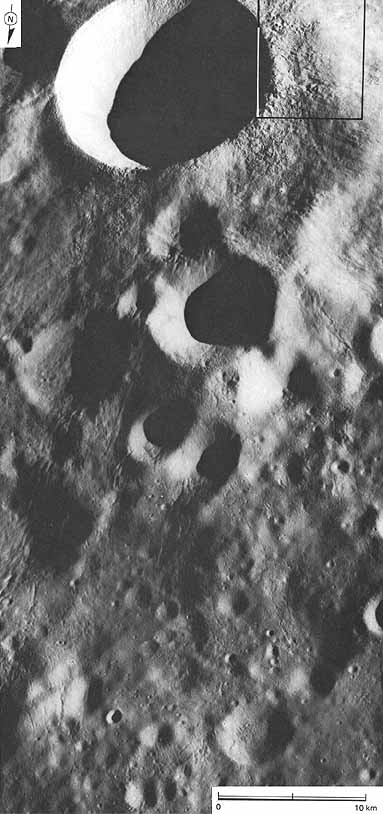 |
|
[113] |
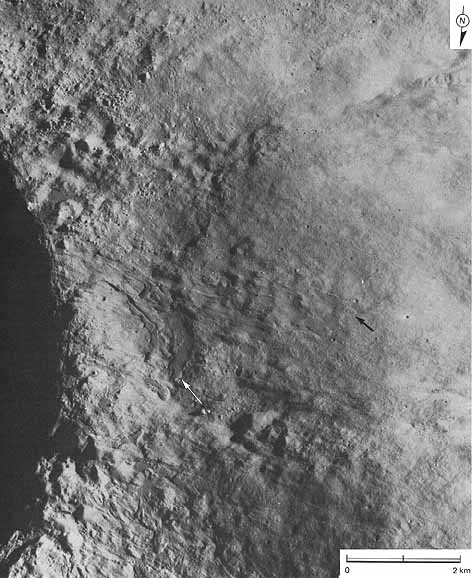 |
FIGURE 104 [above].-This enlarged view of part of figure 103 shows some of the smooth flows that originate near the crest of the crater rim at the left side of photograph. Arrows point to the lower ends of two flows. The origin of the flow material is controversial. It was probably molten material generated by shock-wave compression of lunar rocks and ejected at relatively low velocities during the late stages of the formation of the impact crater; or it may have resulted from the flow of rock debris mixed with a fluidizing agent such as gas or water; or it may have been volcanically generated lava.-H.J.M.
[114] FIGURE 105 [below].-The two bright-rayed craters in this picture have been examined more closely from the lunar surface than those illustrated earlier in this chapter. The larger one, South Ray (5), is located 6.2 km southwest of the Apollo 16 landing point, indicated by an arrow at the top edge. At sampling station 8, 3.4 km from the edge of South Ray, astronauts John Young and Charles Duke sampled some rocks from South Ray that had been deposited as ejecta along one of its numerous rays. Studies of these rocks indicate that South Ray formed about 2.5 million years ago bringing rocks 3.8 billion years old to the surface. The impact that created South Ray crater occurred when Australopithecus lived in Africa-well before contemporary man evolved. The much smaller rayed crater is Baby Ray (B). Its rim crest is much sharper than South Ray's and its rays overlie those of South Ray. Consequently it is younger, possibly having formed within modern man's time span. H.J.M.
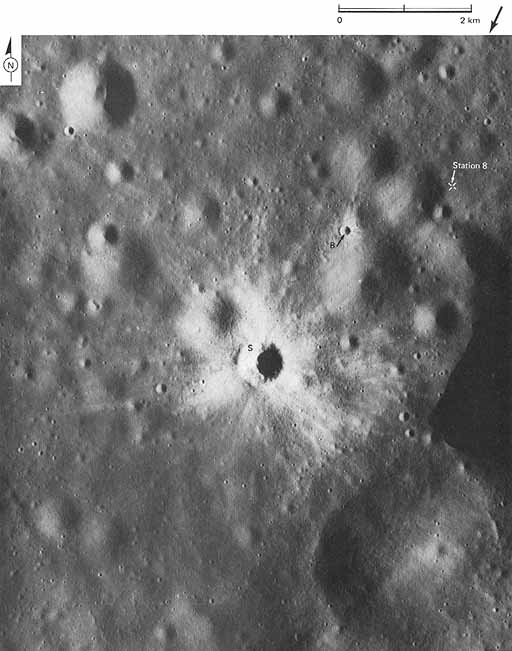
|
[115] FIGURE 106 [right].-Another view of the crater South Ray. This detailed topographic map was prepared under the supervision of S. S. C. Wu of the U.S. Geological Survey by photogrammetric techniques. Prepared from a stereo pair of panoramic camera photographs, it is one of the largest scale maps ever done with Apollo orbital images. The area shown here is a small part of a map that was used for compiling geologic data from the Apollo 16 mission. Dashed lines have been added to the original map to show the crest of South Ray's rim. From this type of topographic representation, the width, depth, slope of the walls, and other parameters can be measured. For example, the maximum depth of the crater, measured from the high point on the rim (7771 m) to the low point in the floor (7628 m), is 143 m.-G.W.C.
|
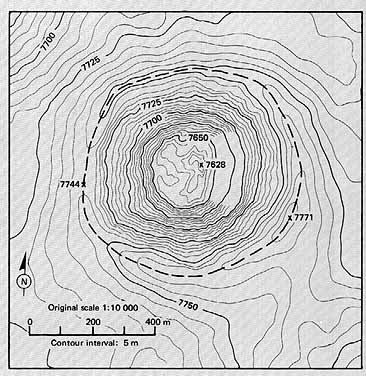 |
|
| |
|
FIGURE 107 [right].-The bright rays around this fresh 1.5-km crater on the Moon's far side show the effects of ejecta thrown out on rugged highlands. The Sun is nearly overhead; therefore, the relief is not conspicuous. When viewed stereoscopically, the crater is seen to be perched on the top of a high bluff that slopes steeply toward the foreground. On top of the bluff, the ray pattern resembles splashes, but on the steep slope the rays cascade in lobes like streamers in a waterfall. The lobes may be avalanches triggered by ejecta striking down on the slope. Dark material on the rim and wall of the crater and pooled in the crater floor may be glassy rocks melted by the impact (Note: This pair demonstrates the problem caused when areas near the ends of unrectified panoramic camera frames are used for stereoscopic viewing. Geometric distortion makes it impossible to view all the overlapped area stereoscopically.)-K.A.H.
|
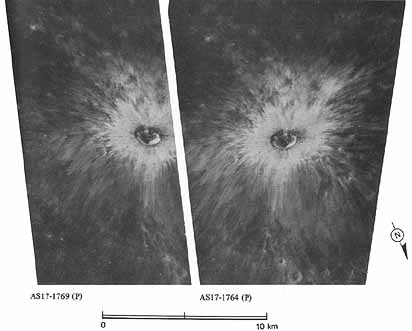 |
| Next |